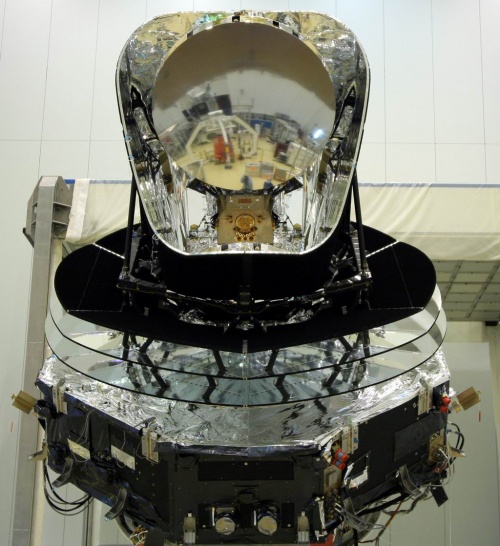Difference between revisions of "The satellite"
| Line 69: | Line 69: | ||
'''Contents of this chapter''' | '''Contents of this chapter''' | ||
| + | |||
| + | <biblio force=false> | ||
| + | #[[References]] | ||
| + | </biblio> | ||
Revision as of 15:16, 28 January 2013
The Planck satellite was designed, built and tested around two major modules:
REFERENCE: #planck2011-1-1
- The payload module containing an off-axis telescope with a projected diameter of 1.5m, focussing radiation from the sky onto a focal plane shared by detectors of the LFI and HFI, operating at 20K and 0.1K respectively; a telescope baffle that simultaneously provides stray-light shielding and radiative cooling; and three conical “V-groove” baffles that provide thermal and radiative insulation between the warm service module and the cold telescope and instruments.
- The service module containing all the warm electronics servicing instruments and satellite; and the solar panel providing electrical power. It also contains the cryocoolers, the main on-board computer, the telecommand receivers and telemetry transmitters, and the attitude control system with its sensors and actuators. The most relevant technical characteristics of the Planck spacecraft are detailed in the Table bellow.
Table. Planck satellite characteristics.
| Diameter | 4.2 m | Defined by the solar array |
| Height | 4.2 m | |
| Total mass at launch | 1912 kg | Fuel mass = 385 kg at launch; He mass = 7.7 kg |
| Electrical power demand (avg) | 1300 W | Instrument part: 685 W (Begining of Life), 780 W (End of Life) |
| Minimum operational lifetime | 18 months | Planck operated for 32 months with both instruments; the LFI continues surveying the sky |
| Spin rate | 1 rpm | $\pm 0.6$ arcmin/sec (changes due to manoeuvers); stability during inertial pointing rpm/h |
| Max angle of spin axis to Sun | 10 deg | To maintain the payload in the shade; default angle is 7.5 deg |
| Max angle of spin axis to Earth | 15 deg | To allow communication to Earth |
| Angle between spin axis and telescope boresight | 85 deg | Max extent of FOV∼ 8 deg |
| On-board data storage capacity | 32 Gbit | Two redundant units (only one is operational at any time) |
| Data transmission rate to ground (max) | 1.5 Mbps | Within 15 deg of Earth, using a 35 m ground antenna |
| Daily contact period | 3 h | The effective real-time science data acquisition bandwidth is 130 kbps |
For more information, see Tauber et al. 2010, A&A 520, A1.
Contents of this chapter
<biblio force=false>
</biblio>
(Planck) Low Frequency Instrument
(Planck) High Frequency Instrument
revolutions per minute
Field-Of-View
